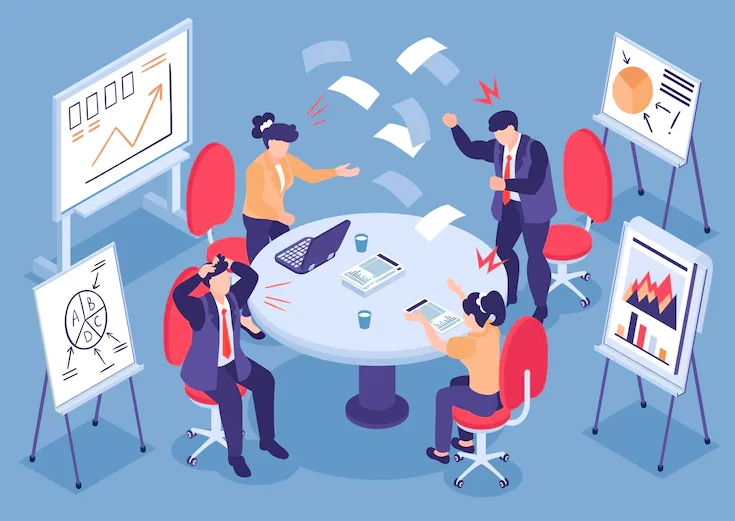Reports reveal that 60% of employees did not undergo basic conflict management training. The lack of necessary skills highly triggers internal fights, unhealthy competition, and workplace stress.
Conflict resolution does not prevent conflicts from happening. Rather, it facilitates healthier discussions that may lead to better decisions and more inclusive choices.
Continue reading to learn more about conflict and the ways to manage it.
To further improve the work environment, it's also advisable to take these career development courses.
The 5 Stages of Conflict
In 1967, University of Pittsburgh Assistant Professor Louis R. Pondy developed the Five-Stage Model of Conflict. The model covers events from when a conflict is still apparent until after its resolution or dissolution.
Each stage represents processes and conditions that trigger a conflict event. The stability or destruction of a company may depend on the interventions applied per stage.
1. Latent conflict or latent stage
In the first stage, Pondy explained that there are 4 common conditions creating the latent potential for conflicts in companies. The said conditions are as follows:
- Competition for scarce resources
- Drive for autonomy
- Divergence of subunit goals
- Role conflict
Latent conflicts are byproducts of inequality. After all, individuals and entities carry different levels of power and influence in a workspace. These factors predetermine the hierarchical flow between workers and departments.
It is difficult to determine the existence of latent conflicts. Since the problem is still inexistent, no one can absolutely predict how it may happen or the extent of injury it can inflict on stakeholders.
2. Perceived stage
During the second stage, parties start to notice the existence of a conflict. At this point, the parties may have received some information or have been exposed to a stimulus. The opposing sides would then insist on their respective interests.
For example, a conflict at the perceived stage occurs when higher-ups notice that a project is late. A team member may have noticed the tardiness and reported it to a superior.
Conflict may occur because one side would want the project accomplished. In contrast, the other side may reason that there is a delay and that their excuse is justifiable. Both parties have clashing goals.
3. Felt stage
The felt stage is where the personalization of conflict happens. Affected parties start experiencing negative emotions because of the conflict and project them onto others. Most of the time, people harbor stress, anxiety, and tension as the problem continues.
Compared to the previous stage, the conflict in the felt stage becomes more tangible. Aside from knowing that there is ongoing trouble, people are starting to develop reactions to the issue.
At this stage, intervenors should control negative emotions as soon as possible. Eliminating stress at work helps improve all involved parties' mental and emotional health. Moreover, it keeps the brewing dilemma from turning into a full-blown fight.
4. Manifest stage
Parties become more vocal and intentional with their actions during the manifest stage. They start doing something to air out their grievances and direct them to the other party.
At this stage, parties engage in actual conflict. People would start demonstrating unruly behaviors, such as being aggressive or disobedient to previously set rules. After feeling the tension, aggrieved parties stir the status quo to change things according to their favor.
Besides expressing their feelings, parties take actions to prevent others from succeeding. For example, when two interests are clashing, parties from opposing ends consciously try to prevent the other from making developments.
5. Aftermath stage
The aftermath stage follows the resolution of a conflict. Typically, one side wins while the other loses. The results will guide parties on how they will interact from now on.
In companies, mishandled conflicts may lead to severe consequences. Those who fail to work through internal issues have an 18% chance of their employees resigning.
To prevent turnovers, leaders and managers should motivate employees. Company heads should ensure that the workers are comfortable in their respective work environments.
One crucial intervention would be teaching workers some stress management tips. Knowing what to do amid unending work stress boosts employees' resiliency against challenges.

7 Tips To Manage Conflict in the Workplace
Companies that adopt effective conflict resolution strategies save up to 80% of potential litigation costs. Before any lawsuit ensues, find the best conflict management protocols that fit your institution's needs.
We have listed some ideas you can incorporate into your conflict management plan. Take a look at the following:
1. Identify whether conflict exists
Conflicts are problematic, but not all problems originate from conflicts. Your conflict management solutions would be inappropriate if no two parties had conflicting interests in the first place.
In workplaces, conflict generally happens when two parties disagree or cannot complement each other. As a result, a work environment becomes discomforting and, to some extent, hostile.
Investigating the root of the conflict will help leaders and managers apply the best solutions. It also traces who among the workers was involved and affected.
2. Schedule a meeting
Staying organized is one of the simplest yet most effective ways to handle stress at work, especially in times of conflict. Start keeping things on track by meeting all concerned parties. Give everyone ample opportunity to say their piece before decisively making resolutions.
Meetings prompt creative progress, too. As people air out concerns and lobby their priorities, leaders and managers may pick out ideas from conflicting parties and combine them to create well-rounded and more efficient solutions.
3. Promote good communication
Poor communication destroys collaboration and organization. A company is like a big team. When members could not coordinate, everybody would do random things without clear plans or goals.
To promote good communication, companies should identify mandatory meeting schedules. Superiors should also be approachable enough to encourage subordinates to reach out.
4. Stay calm
Resolving conflicts requires level-headedness. If a person remains calm, they are more likely to create rational and unbiased decisions.
Applying stress control techniques helps tremendously with maintaining a clear head. Engaging with conflicting parties while having a clouded judgment will not resolve problems. It could even complicate the entire situation.
5. Focus on the solution
It is tempting to dwell on who committed mistakes and caused the existing conflict. However, this mindset is toxic and repetitive.
Instead of condemning someone for their previous involvement in conflicts, companies should prioritize making solutions to prevent similar errors. This way, stakeholders would feel encouraged to be better at their posts.
6. Come up with a conflict resolution plan
A good conflict resolution plan is comprehensive, inclusive, and relevant. Additionally, it should be formally instituted so that everyone in a company would be bound to follow them.
A concretized plan will serve as a reference for people to follow. It will be the first thing they will review when internal conflicts occur.
7. Recognize progress
When you see progress, no matter how small, celebrate them. Recognizing minor improvements could help boost morale and push others to try even harder.
To create more progress, focus on effective team management. Employees, managers, and leaders who work as one unit do not encounter as many internal conflicts as those who lack team coordination.
The Monday app streamlines team collaboration and communication, helping to reduce misunderstandings and prevent conflicts. Its intuitive interface and project management features ensure that everyone stays on the same page, promoting a more harmonious and productive work environment.Get Better at Conflict Resolution
No one can master conflict management overnight. It takes time, effort, and training to settle inconsistent demands and clashing interests between the parties involved. Anyone attempting to get in between feuds should polish their relationship management skills to create meaningful and unbiased resolutions.
Getting better at conflict resolution requires mastery over other skills. Being flexible allows a person to create immediate and new solutions. For that reason, leaders and managers should try learning a wide array of soft skills. These skills should boost conflict resolution skills, too.
Check Skill Success to access a library of courses created by experts but learnable by beginners.
"One thing I always tell people is focus on understanding, not winning. When you truly listen to the other side, it becomes way easier to find common ground. You'd be surprised how often a simple Can you tell me more about why you feel that way? can de-escalate a situation."
Recommended Courses
1. Conflict Management With Emotional Intelligence
 "Conflict Management With Emotional Intelligence" teaches how to handle and resolve conflicts using emotional intelligence. It covers the causes of conflict, how to use emotional intelligence to manage it, and practical techniques for better communication and understanding.
This course combines emotional intelligence with conflict management through interactive exercises and real-life applications. It emphasizes flexibility, behavioral preferences, and adaptability, offering a comprehensive approach to resolving conflicts.
The course is practical and insightful. The interactive exercises helped me immediately apply the concepts. The focus on emotional intelligence in conflict resolution provided useful tools for better communication.
"Conflict Management With Emotional Intelligence" teaches how to handle and resolve conflicts using emotional intelligence. It covers the causes of conflict, how to use emotional intelligence to manage it, and practical techniques for better communication and understanding.
This course combines emotional intelligence with conflict management through interactive exercises and real-life applications. It emphasizes flexibility, behavioral preferences, and adaptability, offering a comprehensive approach to resolving conflicts.
The course is practical and insightful. The interactive exercises helped me immediately apply the concepts. The focus on emotional intelligence in conflict resolution provided useful tools for better communication.
Who is this course for?
Ideal for anyone involved in managing or resolving conflicts, professionally or personally. Perfect for those wanting to develop emotional intelligence and apply it to conflict resolution. If you're ready to engage in practical exercises, this course will enhance your conflict management skills. Take this course2. Conflict Management And Crucial Communications
 Designed to teach the essentials of conflict management and crucial communications, this course helps you deliver difficult messages while maintaining respect and appreciation for others. It provides a straightforward, seven-step process for managing challenging conversations.
Offering a practical, step-by-step approach to difficult conversations, this course includes real-life examples and practice opportunities. Its focus on preparation, presentation, listening, and agreeing on next steps ensures a comprehensive improvement in communication skills.
I found this course very practical and easy to follow. The seven-step process for difficult conversations is clear and effective. The real-life examples and practice opportunities made the concepts immediately applicable.
Designed to teach the essentials of conflict management and crucial communications, this course helps you deliver difficult messages while maintaining respect and appreciation for others. It provides a straightforward, seven-step process for managing challenging conversations.
Offering a practical, step-by-step approach to difficult conversations, this course includes real-life examples and practice opportunities. Its focus on preparation, presentation, listening, and agreeing on next steps ensures a comprehensive improvement in communication skills.
I found this course very practical and easy to follow. The seven-step process for difficult conversations is clear and effective. The real-life examples and practice opportunities made the concepts immediately applicable.
Who is this course for?
Perfect for anyone looking to enhance their communication skills, especially in handling difficult conversations. Whether you're a professional or just looking to improve personal interactions, this course provides valuable tools for managing conflict and crucial communications effectively. Take this course3. Conflict Management In The Workplace
 "Conflict Management In The Workplace" is designed for those seeking effective techniques to manage workplace conflicts. It focuses on identifying, understanding, and resolving disputes with colleagues or customers.
This course emphasizes practical conflict resolution skills, helping learners understand conflict causes, types, and their own management styles. It offers actionable techniques to handle conflicts, fostering a positive work environment.
This course is practical and insightful, providing clear guidance on identifying and resolving conflicts. The focus on real-world application and understanding different conflict styles makes it very useful for daily workplace interactions.
"Conflict Management In The Workplace" is designed for those seeking effective techniques to manage workplace conflicts. It focuses on identifying, understanding, and resolving disputes with colleagues or customers.
This course emphasizes practical conflict resolution skills, helping learners understand conflict causes, types, and their own management styles. It offers actionable techniques to handle conflicts, fostering a positive work environment.
This course is practical and insightful, providing clear guidance on identifying and resolving conflicts. The focus on real-world application and understanding different conflict styles makes it very useful for daily workplace interactions.
Who is this course for?
Perfect for anyone interacting regularly with colleagues or customers. Whether you're a manager or team member, this course offers valuable tools to handle conflicts confidently and improve workplace relationships. Take this courseFrequently Asked Questions
How can I identify latent conflict in the workplace?
Latent conflict can be identified by recognizing underlying factors such as resource scarcity, differing goals or values among team members, or structural inequalities. It often requires a proactive approach to notice these potential issues before they escalate.What are some signs of perceived conflict?
Signs of perceived conflict include recognition of disagreements or differences in opinion, goals, or values among parties. It becomes evident when individuals or groups realize that their needs, interests, or concerns are incompatible with those of others.How do emotions influence felt conflict?
Emotions play a significant role in felt conflict by intensifying the perception of the conflict and influencing behavior. They can lead to increased stress, frustration, and anger, making the conflict feel more personal and harder to resolve objectively.What behaviors are common in the manifest conflict stage?
In the manifest conflict stage, behaviors such as arguing, competing, avoiding, or accommodating are common. This stage is characterized by visible actions taken by parties involved in the conflict, including verbal disagreements and attempts at dominance.What strategies can be used for conflict resolution?
Effective strategies for conflict resolution include negotiation, mediation, arbitration, and collaboration. Choosing the right strategy depends on the nature of the conflict, the relationship between the parties, and the desired outcome."For conflict management at Zoop, creating a culture of accountability stands out as a paramount principle. As the visionary Founder, I firmly believe that accountability cultivates a sense of responsibility and ownership among team members. When conflicts arise, instilling a commitment to owning one's actions and decisions helps in finding solutions collaboratively. It establishes a framework where everyone is empowered to contribute positively to conflict resolution. This not only streamlines our operations but also contributes to a dynamic and resilient work environment. At Zoop, we recognize that embracing accountability is fundamental to ensuring our journey on the culinary innovation express remains smooth and satisfying for both our team and customers."

